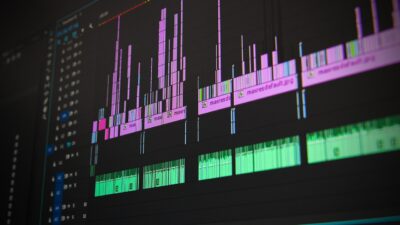Table of Contents[Hide][Show]
- WRAL’s Multiplatform Strategy For Local News
- WRAL’s HD News Gathering Efforts
- How WRAL’s Studio Anchors Are Adapting To New HD And Digital Video Workflows
- Managing Third-Party Content Rights And Advertising For Digital Distribution
- WRAL Is Making The Internet A Part Of The Station’s Video Distribution Strategy
- Is The Future Of Local News Going Digital?
WRAL has a longstanding reputation for innovation in the broadcast industry, with notable achievements such as being among the first to launch an HDTV channel in the mid-1990s and broadcasting live HDTV newscasts starting in the Fall of 2000. They are now extending that innovation streak again, this time to portable digital video.
WRAL’s Multiplatform Strategy For Local News
WRAL is a CBS affiliate in Raleigh, North Carolina that is pioneering the way news is distributed. While many television broadcasters are still exploring the idea of distributing news across multiple platforms, WRAL is already doing it.
WRAL broadcasts news programming live on its main channel, Channel 5, from 7 a.m. to 11 p.m., Monday through Friday. The station also airs a 30-minute newscast at noon and a 1-hour newscast at 6 p.m.
In addition to its main channel, WRAL also distributes news programming on a variety of other platforms, including its website, and mobile phone services. The station’s website offers live streaming of newscasts, video on demand, and news snippets. The mobile experience provides users with access to the same content as the website, as well as breaking news updates.
Several WRAL TV newscasts, including the noon edition, can be accessed through multiple platforms for convenient viewing. Not only are they streamed live on the station’s website, WRAL.com, but they are also available as snippets on mobile phones through Sprint. Moreover, WRAL has embraced innovative technology to offer an updated 15-minute “news wheel” that can be accessed on-demand through their website and on WRAL’s News Channel. This channel is broadcasted on WRAL-DT’s DTV sub-channel 5.2, which is widely available through local cable companies.
Since the launch of their website in 1996, WRAL has consistently provided a range of video on demand content, including news, special reports, and documentaries. In fact, they have even made certain programming available for purchase on DVD.
According to Peter A. Sockett, the chief engineer for WRAL, their approach involves producing tailored programming for each outlet and its viewers. The station has invested considerable time and effort to design and integrate the necessary technology, ensuring a seamless workflow that allows them to serve all these outlets efficiently and cost-effectively.
WRAL’s HD News Gathering Efforts
With HD in mind, WRAL has been at the forefront of adopting high-definition (HD) technology in their news gathering operations. They took a significant step by purchasing and deploying a helicopter equipped with an HD camera and lens. Unlike many stations that simply upgrade their standard definition (SD) news to HD, WRAL’s approach involves using Panasonic DVCPRO HD camcorders to shoot native 16:9 HD footage in the field. This ensures high-quality visuals right from the source. Currently, their HD electronic news gathering (ENG) operation relies on a tape-based system, but they are actively exploring disk-based recording options for future implementation.
When WRAL’s news photographers venture out to cover stories, they capture footage in native 16:9 1080i HD, while also ensuring that they account for the 4:3 safe area. They understand that the station’s various outlets, such as the 24/7 DTV News Channel and website, offer more flexibility in terms of time constraints compared to traditional half-hour newscasts. This allows WRAL to deliver comprehensive news packages rather than being limited to 30-second clips. The captured video is edited into shorter or longer segments based on the requirements of each outlet.
When WRAL’s news footage returns to the station, it is ingested into their BitCentral video server, which is connected as a Storage Area Network (SAN). The server network links 11 Canopus Edius nonlinear HD/SD workstations capable of editing in full HD resolution.
The Canopus Edius desktop non-linear editor (NLE) was the ideal choice for their operation because it enables editors to mix different video formats and resolutions on the same editing timeline. Additionally, the Canopus system includes a built-in encoder that allows the finished HD news segments to be outputted as either HD or SD, providing versatility in distribution formats.
This workflow allows WRAL to produce high-quality news content quickly and efficiently, regardless of the platform on which it will be distributed.
How WRAL’s Studio Anchors Are Adapting To New HD And Digital Video Workflows
To ensure a polished and cohesive presentation, WRAL’s news anchors are brought into the studio where they read news copy from teleprompters, introducing each news segment in the news wheel. This attention to detail adds a professional touch to the 15-minute presentation. Since the original media was shot in HD, the down-converted video on the web exhibits exceptional clarity when played on platforms like Real Video, QuickTime, or Windows Media Player.
The news wheel, along with the News Channel, is available on weekdays from 8 a.m. to 7 p.m., specifically targeting viewers who are at work, according to John Conway, WRAL’s VP of Digital.
Throughout the day, WRAL’s news producers continually update the 15-minute news wheel with fresh stories and weather reports. Separate news teams are dedicated to producing live newscasts for WRAL and FOX50, as well as for the news wheel that runs continuously on the web and the DTV News Channel. Additionally, the website offers other video content such as documentaries and special features, accessible on demand.
The advantage of producing fresh programming for each outlet is the ability to cross-promote content shown live on the air or streamed on WRAL.com. This innovative approach allows the station to occasionally air news content first on their website before broadcasting it on their DTV channels, effectively turning the traditional broadcast model around.
During significant news stories, news anchors often direct viewers to additional material, such as full press conferences, available on the station’s 24/7 new media outlets. Although the current news wheel does not cover sports, Conway envisions a future where WRAL and FOX50 could provide multiple 24/7 “channels” on the internet, catering to high school sports, traffic updates, and other advertiser-supported niche programming.
Managing Third-Party Content Rights And Advertising For Digital Distribution
Respecting the rights associated with third-party produced programming and commercials is a crucial consideration for WRAL. An example of this is WRAL’s noon newscast, which they stream simultaneously on WRAL.com. WRAL’s traffic department has to ensure that it books commercials that are approved for national viewing. Otherwise, local advertisers would waste impressions on viewers out of market.
WRAL also has content partnerships with third-parties that restrict it from sharing that content outside of the Raleigh-Durham DMA. So special care needs to be taken with specific segments, or sporting events, that could violate any agreements.
WRAL Is Making The Internet A Part Of The Station’s Video Distribution Strategy
WRAL is actively exploring the possibility of making all its digital streaming news content available on WRAL.com, effectively transforming PCs into television screens. Capitol Broadcasting Company CEO Jim Goodman expressed this vision in a recent webcast, which is now archived on the website. He explained that the station intends to restrict viewers outside of their coverage area from receiving the signal on their PCs by utilizing technology that leverages zip code information.
Goodmon, further predicted that advancements in Internet-related technologies will eventually enable streaming video to be of full-screen HDTV quality. To enforce the access restrictions, WRAL has partnered with Decisionmark, and their technology called TitanCast. Decisionmark has developed a comprehensive database using information provided by over 2,000 TV stations across the country, defining the coverage areas for each station. When viewers sign up for TV via the internet, they enter their credit card information, which Decisionmark utilizes to verify their location and grant access to programming available over the air via antenna.
WRAL initially launched this service on a limited basis, using station employees as a testbed for the initiative. However, the issue of copyrights pertaining to affiliate stations carrying network programming and third-party content on their websites is still unresolved.
WRAL.com enjoys significant popularity, with approximately 30 million page views per month. In fact, a research report from International Demographics, Inc., based in Houston, ranked WRAL.com as the second most viewed local media platform in the United States, surpassing print, TV, and radio outlets, with only The Washington Post ahead.
According to Sockett, WRAL recognizes that viewers desire access to their preferred programming across multiple platforms. As an example, in July 2006, WRAL produced “The Parade of Tall Ships” in HDTV for their main channel, streamed it on the web, offered it as video on demand, and even successfully sold the show on DVD via their website. The show showcased the remarkable capabilities of WRAL’s engineers, who utilized Nucomm wireless HD cameras mounted on various ships and boats to capture breathtaking views that would otherwise have been impossible.
Sockett emphasized the critical role of the internet in WRAL’s future strategy and growth. The station believes that providing news in the way viewers prefer is essential, and the trust and loyalty viewers have for WRAL extends to their website.
Is The Future Of Local News Going Digital?
WRAL’s commitment to distributing news across multiple platforms is a reflection of the changing way people consume news. In the past, people would typically watch the news on television. However, with the rise of the internet and mobile devices, people are now able to access news content on a variety of platforms. WRAL is committed to providing viewers with news in the format they want it, and its distribution of news across multiple platforms is a key part of that commitment.
In summary, WRAL Channel 5 offers a diverse range of programming options through their website, mobile phones via Sprint, and its dedicated News Channel. Their commitment to tailored content and technological advancement has solidified their position as pioneers in the industry.
Urooj is a freelance writer of some repute, even if she says so herself. Her goal in life is to be published in every international magazine and visitor-load-weary website. She can be contacted at kaziurooj [at] gmail [dot] com.












 Amy Poehler and Seth Meyers Make Their SNL Weekend Update Debut (2006)
Amy Poehler and Seth Meyers Make Their SNL Weekend Update Debut (2006)
Leave a Reply
You must be logged in to post a comment.